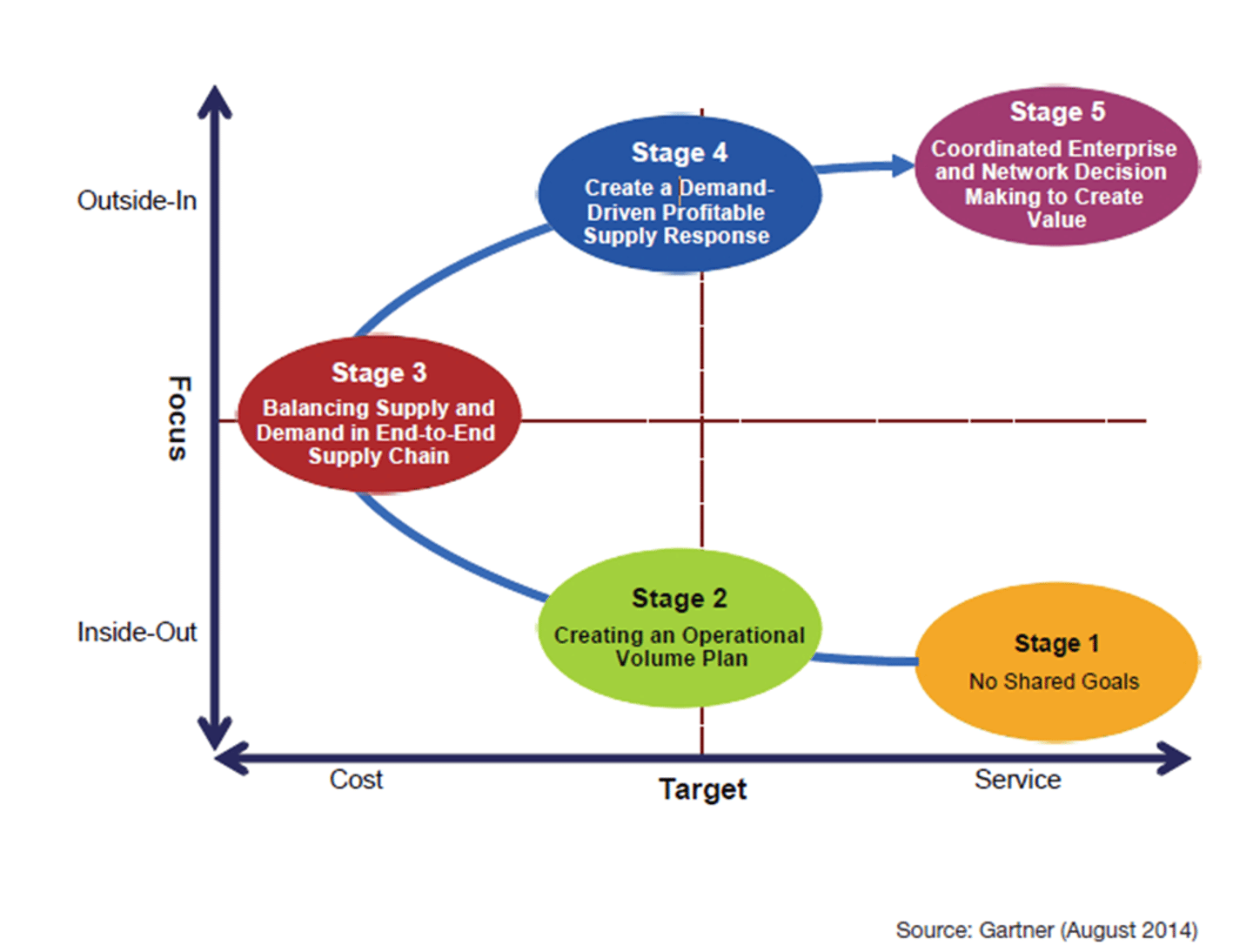Climbing the Sales & Operations Maturity Ladder, Stage 3
The benefits of developing mature sales and operations planning capabilities are well documented. In fact, S&OP is one of the most discussed and written-about topics in the world of supply chain management. In survey after survey S&OP consistently ranks as one of the top three management priorities. Why is it then that many organizations find it extremely difficult to improve their ability to develop a company-wide planning process?
This is the second in a series of three articles that discuss the characteristics of S&OP process maturity and recommended actions to move to higher levels of capability maturity.
More Details on the Gartner Five-Stage S&OP Maturity Model
Gartner’s model describes the maturity of a company’s S&OP capability across six dimensions for each of their five defined stages of maturity. These dimensions include outcome, process focus, organization, metrics, time horizon, and technology. A company may be at a different S&OP maturity stage for each dimension. For instance, a company might have a strong S&OP process that includes commercial and financial inputs characterized by a Stage 4 Process Focus Maturity but still use spreadsheets and in-house systems to support their S&OP process characterized by a Stage 1 Technology Maturity. For more information on Stages 1 & 2, read the first part in this series: Climbing the Sales & Operations Maturity Ladder – The First Steps.
Stage Three: Integrate
Reaching stage three S&OP maturity is often referred to as the point when a company turns the corner and starts to shift their focus to outside-in capabilities. Stage three companies have developed standard and repeatable processes. Their demand plans consider new products and incorporate sales and key partner inputs to build a true estimate of the total opportunity. In stage three companies, demand plans are used to develop purchasing plans and constrained manufacturing plans, and companies analyze and address gaps between unconstrained demand and constrained supply.
Stage three companies have an S&OP process champion who sets strategy and helps to ensure participation from all key functions. The supply chain team plays the central role in collecting data, analyzing the data, and coordinating the S&OP process. Executives responsible for Profit and Loss are involved making tradeoff decisions.
Usually by stage three maturity cross-functional KPIs become more common which helps drive alignment and creates incentives to work towards common goals. The S&OP process is focused on a repeatable monthly series of planning meetings and the associated activities to build and analyze data culminating in an executive S&OP meeting. Stage three companies tend to focus on the mid-term planning horizon and at some level of product aggregation.
Setting Your Sights on Stage Four “Collaborate”
- Supply Chain Data Management: Clean, consistent, comprehensive, current, controlled and convenient data is a must. It is essential to establish repeatable and automatic data interfaces between the S&OP platform and the various enterprise and supply chain systems that feed and receive data.
- Advanced Sales & Operations Planning Solution: Basic planning solutions, spreadsheets, homegrown and ERP systems do not provide the advanced capabilities needed to facilitate more mature S&OP processes.
- Algorithmic-Based Analysis: To facilitate fast and more optimal decisions, stage three companies need to invest in algorithmic planning capabilities to determine impacts on the end-to-end supply chain.
- Multi-Horizon Planning: Stage three companies should start to extend their long-range planning horizon to enable full integration with multi-year strategic planning to ensure strategic plans are accurately translated to tactical and operational plans.
S&OP Process Maturity Checklist: Beyond Stage 3
- Fast simulations and what-if scenarios
- Actuals versus plan comparisons
- Financial and volumetric plans
- Product lifecycle planning
- Risk analysis
- Multi-horizon/region/division/segmentation planning
- Translation between detailed and aggregate plans
- Internal and external collaboration
- Supply chain master and transactional data management
A mature S&OP process supported by an advanced S&OP platform ensures business plans are synchronized and rooted in feasible supply chain network capabilities and resources and investments are deployed where they are most effective in achieving business goals.
The next and last article in this series “Climbing the Sales & Operations Maturity Ladder – Reaching for the Peak,” set for release in December, will explore the characteristics of the higher stages of S&OP maturity, actions to climb the maturity ladder and recommendations on how to run an effective executive S&OP meeting.
Hank Canitz is product marketing director at Logility. Hank brings more than 25 years of experience building high performance supply chains. This experience includes evaluating, selecting, implementing, using and marketing supply chain technology. Hank’s graduate degree in SCM from Michigan State, numerous SCM certifications, diverse experience as a supply chain practitioner and experience in senior marketing roles with leading supply chain solution providers helps him to bring a unique perspective on supply chain best practices and supporting technology to the Logility Blog.



